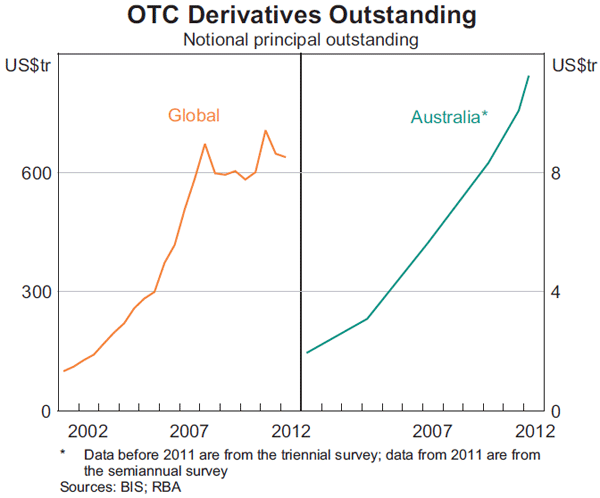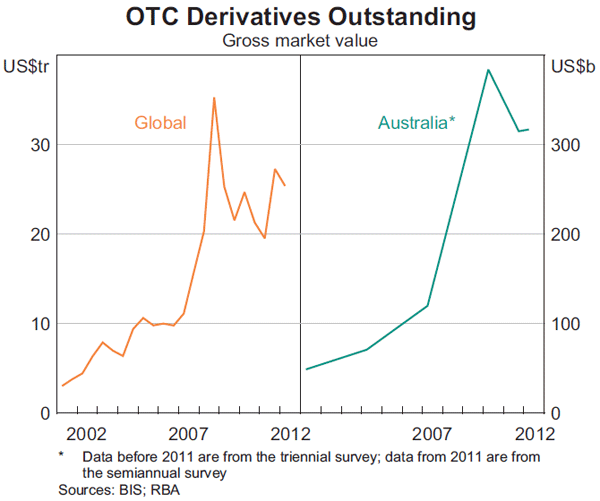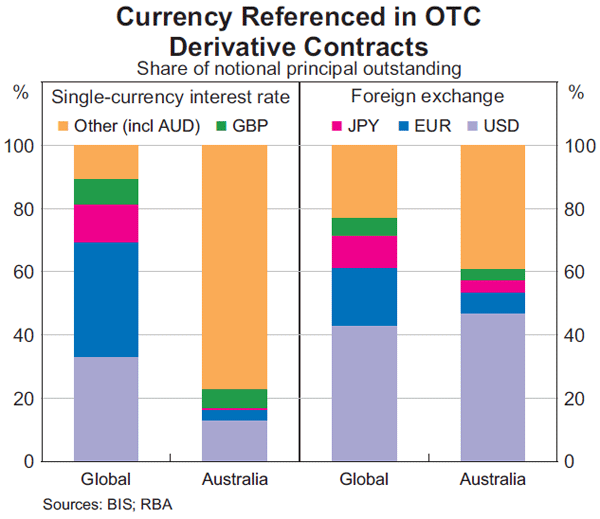Bulletin – December 2012 Australian OTC Derivatives Markets: Insights from the BIS Semiannual Survey
- Download the article 262KB
Abstract
The Reserve Bank of Australia recently commenced surveying participants in Australian over-the-counter (OTC) derivatives markets as part of the Bank for International Settlements' (BIS) semiannual global OTC derivatives survey. Australia's contribution to the survey complements regulatory efforts to improve the resilience and transparency of Australia's OTC derivatives markets. It also facilitates a higher frequency comparison of the Australian and foreign OTC derivatives markets. The survey results show that the structure of the Australian market is broadly similar to that of global markets: Australia's market is primarily an interbank market, with most activity in interest rate and foreign exchange derivatives contracts.
Introduction
OTC derivatives markets have attracted considerable attention from regulators since the onset of the global financial crisis. Reforms to improve the risk management practices and transparency of these markets are now underway in many jurisdictions, including Australia. These reforms include the reporting of all OTC derivatives transactions to trade repositories, the execution of transactions on organised trading platforms (where appropriate), the clearing of standardised trades through central counterparties, and the collateralisation of bilateral transactions not cleared through central counterparties.[1]
Complementing other initiatives to increase transparency in these markets, the Reserve Bank of Australia recently began surveying a selection of Australian banks as part of the BIS semiannual collection of OTC derivatives statistics, in addition to its long-running contribution to the BIS triennial survey. The semiannual collection has been the most authoritative source of data on global OTC derivatives markets to date. The Australian contribution provides an additional resource for local regulators to observe Australian banks' activity in these markets. For example, it includes a comprehensive and higher frequency breakdown of the Australian market by product class, counterparty type, maturity profile and currency denomination. The survey will also assist in quantifying the impact on Australian banks of impending reforms in these markets. The BIS semiannual collection supplements other sources of data on institutions' OTC derivatives markets activity and exposures collected by the Australian Prudential Regulation Authority (APRA) and the Australian Financial Markets Association (AFMA), as well as ad hoc surveys carried out in 2009 and 2012 by APRA, the Australian Securities and Investments Commission (ASIC) and the Bank.[2]
Overview of the BIS Survey
The BIS semiannual survey gathers comprehensive and comparable information on OTC derivatives markets from the most active market participants located in the largest developed economies.[3] The survey started in 1998, covering banks from the G10 countries and Switzerland, and was expanded to include Australia and Spain from the December 2011 survey. The semiannual survey is supplemented by a more comprehensive triennial survey, to which Australia has contributed since 2001. Australia's data are collected by the Bank on behalf of the BIS.
The Australian survey involves six Australian banks that play a key role in intermediating local and Australian dollar-denominated OTC derivatives markets.[4] These banks also enter into derivatives contracts for their own risk management and business purposes. Survey respondents report on a global consolidated basis, whereby the banks aggregate activity across their global operations (netting out intragroup transactions) and report in the country in which their global headquarters are located.[5] As a result, the activities of foreign banks in the Australian market are captured in the statistics of their home jurisdictions.
The survey is representative of Australian OTC derivatives markets. The six reporting banks constitute around two-thirds of the notional principal amounts outstanding reported to APRA by local and foreign banks operating in Australia, and represent a much higher share of foreign exchange and credit-related derivatives contracts (Graph 1). The remaining third of OTC derivatives outstanding reported to APRA are mostly written by foreign banks operating in Australia; these activities are recorded in their home jurisdictions for the purposes of the BIS survey.[6] The BIS and APRA data, along with turnover data from AFMA, indicate that the local markets are quite concentrated, with 85 to 90 per cent of transactions in each OTC product class accounted for by eight or fewer banks, although this is typical of derivatives markets globally.

APRA data suggest that the overwhelming majority of OTC derivatives positions reported by the six Australian banks are entered into by their Australian domiciled entity. In other words, the Australian contribution to the BIS survey is representative of activities occurring within the Australian market.
Measures of OTC Derivatives Market Size
There is no single universally accepted measure of derivatives market size, and the BIS survey collects data on three metrics (see ‘Box A: Understanding the Three Measures of Market Size’ for an explanation of these different measures). The most common measure of market size is to aggregate contract notional principal amounts, which represent the value used to calculate payments made on a derivative contract. By this measure, global OTC derivatives contracts outstanding have grown roughly sixfold over the past decade, although growth has slowed since the onset of the global financial crisis in 2008. The notional principal of global contracts at the end of June 2012 stood at around US$640 trillion, while the notional principal of Australian reporting bank contracts outstanding totalled a little over US$11 trillion, around 1.7 per cent of the global stock (Graph 2).[7]

The extremely large notional values of OTC derivatives contracts – around nine times global GDP – do not reflect the risk associated with these contracts. For many transactions, including the largest single derivative class – interest rate swaps – the notional principal is never exchanged; it is only used to calculate cash flows, and so significantly overstates an entity's exposure to credit and market risk. An alternative measure of the size of a derivatives market is its gross market value, which measures the current replacement cost of a contract; that is, the sum of the absolute values of the position to both parties. The aggregate gross market value of OTC derivatives of reporting Australian banks is just over US$300 billion, around 1 per cent of the total global gross market value, and considerably smaller than Australian banks' notional principal amounts outstanding. Gross market values are sensitive to price changes in the underlying reference variable, and so reflect both the use of derivatives contracts as well as observed market volatility. For instance, gross market values rose significantly in 2008 and 2009 as underlying reference prices moved sharply, causing large mark-to-market gains and losses for contract holders (Graph 3).

Much of the notional principal amounts outstanding and gross market values reflect the build-up between counterparties of economically redundant (i.e. offsetting) positions.[8] A third measure of market size, gross credit exposures and liabilities, adjusts gross market values to account for legally enforceable bilateral netting arrangements between counterparties, and so represents the after netting claims and obligations reporting banks have on their counterparties. Globally, gross credit exposures and liabilities have declined steadily over the past decade when scaled by other market measures, as counterparties have made greater use of netting to reduce credit and settlement risk. Australian gross credit exposures and liabilities are over twice the global average as a share of gross market values (Graph 4). This largely reflects the fact that the reporting Australian banks tend to be on one side of cross-currency swap positions, which they use to hedge their offshore funding, and so are unable to net exposures with counterparties.

Box A: Understanding the Three Measures of Market Size
Assume Bank A and Bank B enter into a five-year fixed-for-floating single-currency interest rate swap with a notional principal of $1 million. Bank A agrees to pay Bank B a fixed rate of 5 per cent per annum on $1 million, while Bank B agrees to pay Bank A a floating interest rate on $1 million (Figure A1). The notional principal amount generated by this contract is $2 million (although this amount is never exchanged).

As the floating interest rate changes, the market value of the contract varies for each bank. If, for example, the floating interest rate were to increase, the contract would have a positive market value for Bank A and a negative market value for Bank B. Assume this market value is +$10,000 for Bank A and −$10,000 to Bank B. Under the BIS reporting guidelines, the sum of the absolutes of these market values, +$20,000, is the contract's gross market value.
Suppose the two banks have a pre-existing derivative contract of which the market value is −$3,000 to Bank A and +$3,000 to Bank B. In this case, the two banks are able to net these exposures such that Bank A's net claim is $7,000 and Bank B's net obligation is $7,000. In this case, the gross credit exposures and liabilities of the contracts is $14,000.
Characteristics of the Global and Australian OTC Derivatives Markets
The BIS data show that the largest segments of both global and Australian OTC derivatives markets are interest rate and foreign exchange contracts, which follows from the extensive use of these instruments for hedging purposes by financial institutions. Collectively, these instruments account for around 90 per cent of global and Australian notional principal and gross market values outstanding (Table 1). Although market turnover is much higher for foreign exchange contracts, single-currency interest rate contracts represent the bulk of outstanding contracts due to their much longer average maturity. These interest rate contracts are primarily fixed-for-floating swap contracts, and in the Australian market are largely Australian dollar-denominated.
| Australia | Global | |||
|---|---|---|---|---|
|
Share of notional principal outstanding |
Share of gross market value outstanding |
Share of notional principal outstanding |
Share of gross market value outstanding |
|
| Foreign exchange(a) | 32.2 | 35.1 | 11.2 | 9.4 |
|
Single-currency interest rate |
64.7 | 57.8 | 82.8 | 81.2 |
| Credit | 1.4 | 1.3 | 4.5 | 5.0 |
| Equity | 0.4 | 1.0 | 1.0 | 2.7 |
| Commodities | 1.3 | 4.8 | 0.5 | 1.7 |
|
(a) Includes cross-currency swaps Sources: BIS; RBA |
||||
Around half of all foreign exchange (FX) derivatives instruments are FX swaps and a further 40 per cent are cross-currency swaps.[9] The remainder are largely FX forwards and options. Commodity, credit and equity derivatives represent a much smaller portion of the OTC market, in part reflecting the lower number of transactions in these instruments and the much lower principal amounts applied to the typical contract.
FX derivatives comprise a higher proportion of Australian banks' outstanding derivatives positions relative to the typical large global bank. This in part reflects the significant use of long-dated cross-currency swap contracts by the Australian banks for hedging their own offshore borrowings. Counterparties to these transactions tend to be foreign non-resident banks.
The Australian banks have a smaller share of credit-related derivative contracts outstanding relative to the global average, although this reflects the very large size of the US corporate bond market (on which credit default swaps (CDS) contracts are written), rather than Australia's corporate bond market being particularly small. Conversely, the Australian banks have around three times the global share of commodity contract positions, reflecting the relatively high share of resource sector activity in the Australian economy.
Both the global and Australian markets are concentrated in a few major currencies. The overwhelming majority of global outstanding contracts are denominated in US dollars, euros, Japanese yen and British pounds (the G4 currencies), reflecting the large size of these economies and financial markets (Graph 5). Globally, ‘other’ currencies, which include the Australian dollar, account for 10 per cent of outstanding interest rate contracts and 23 per cent of foreign exchange contracts. In contrast, Australian dollar contracts represent up to 80 per cent of outstanding interest rate contracts reported by the Australian banks, reflecting both their market-making position in the Australian market and their own hedging activities.[10] Similarly, around three-quarters of foreign exchange contracts outstanding in Australia have either an Australian dollar or US dollar leg (or both), reflecting the fact that the US dollar is the primary foreign funding currency for Australian banks and corporates.

Both the global and Australian OTC derivatives markets are predominantly interbank markets. Over 90 per cent of outstanding contracts globally and in Australia are between banks (including both BIS reporting banks and non-reporting banks), with the remainder involving non-financial corporations (Graph 6). Just under half of all outstanding contracts globally involve two BIS reporting banks, reflecting the concentrated nature of the market. This share is even higher in Australia, where positions with reporting banks constitute around 70 per cent of notional values.

In June 2010, the BIS expanded the semiannual survey to include more detailed information on credit-related derivatives, which are primarily CDS.[11] CDS referencing a single entity (i.e.‘single-name’CDS) comprise the majority of the CDS market globally and mostly reference non-financial corporates and financial institutions, reflecting their use for transferring credit risk between financial institutions (Graph 7). In contrast, Australian banks write more multi-name CDS contracts, mostly referencing standardised indices that track a set of CDS contracts. This reflects the fact that relatively few Australian corporates have sufficient debt outstanding to be referenced by liquid single-name CDS contracts.

Globally, the majority of CDS contracts reference investment grade firms, although a sizeable minority – around 40 per cent of contracts – reference sub-investment grade or unrated firms (Graph 8). In contrast, a greater share of contracts arranged by the Australian banks reference investment grade firms, in part reflecting the small size of Australia's sub-investment grade corporate bond market.

Conclusion
Australia's contribution to the semiannual BIS OTC derivatives survey complements global efforts to improve the transparency of these markets. For Australian regulators, reporting by Australian banks facilitates a comparison of local and global derivatives market characteristics and trends. Overall, Australia's market has a similar structure to offshore markets, with differences largely reflecting structural features of the Australian economy, the relatively small size of Australia's bond markets, and the significant use of derivatives by the Australian reporting banks for their own hedging activities.
Footnotes
The article was written by Mihovil Matić and Christian Vallence. Jason Ahn was responsible for establishing and administering the survey. The authors are from Domestic Markets Department and would like to thank Greg Moran for his assistance and comments. [*]
In Australia, the Council of Financial Regulators has stated its preference for industry-led implementation of the reforms, with direct regulatory intervention if desired outcomes are not reached within acceptable time frames. See Council of Financial Regulators (2012). This policy stance was reaffirmed in a detailed report on OTC derivatives markets in Australia released in October, which included an assessment of whether direct regulatory intervention was required. See APRA, ASIC and RBA (2012). [1]
See APRA, ASIC and RBA (2009, 2012). [2]
See BIS (2012) for the global survey data and discussion. [3]
The six reporting banks are Australia and New Zealand Banking Group, Commonwealth Bank of Australia, Macquarie Bank, National Australia Bank, Suncorp-Metway and Westpac Banking Corporation. [4]
Other surveys of Australian OTC derivatives markets have used a different reporting basis, reflecting their single-country focus. For example, the surveys conducted by APRA, ASIC and the RBA in 2009 and 2012 captured information about transactions either booked or executed by an ‘Australian-based entity’ (defined as an entity incorporated in Australia, or the branch or office of an overseas entity registered in Australia). [5]
There are additional transactions executed by foreign banks in Australia but booked in foreign financial centres that are not captured by the APRA data. [6]
BIS reporting banks disclose the value of their transactions conducted with all other reporting banks globally, but do not separately identify the value of transactions conducted with reporting banks within their home jurisdiction. Accordingly, notional principal amounts outstanding between Australian banks are counted twice, whereas the BIS is able to adjust for double counting at a global level by halving aggregate outstandings between reporting banks. Given this, Australian positions are somewhat overstated relative to global positions, although the effect of this double counting is estimated to be small, as confidential transaction level data collected by APRA indicate that most Australian bank transactions are conducted with non-Australian banks. [7]
Market participants can use ‘trade compression’ services to replace redundant contracts with a smaller number of economically equivalent contracts. For example, use of these services by large international banks contributed to a notable reduction between 2007 and 2009 in the global notional value of credit default swaps outstanding. However, use of trade compression by the Australian market has been somewhat sporadic to date. [8]
FX swaps are instruments that involve the exchange of two currencies for a short period of time, whereas cross-currency swaps are longer-dated instruments that involve the exchange of currencies and periodic interest payments with the counterparty. [9]
Although the BIS data do not separately identify Australian dollar contracts, AFMA turnover data show that trading by Australian banks in currencies other than the G4 currencies are almost exclusively in Australian dollars. [10]
See Fabbro (2011) for a discussion of the Australian CDS market. [11]
References
APRA, ASIC and RBA (Australian Prudential Regulation Authority, Australian Securities and Investments Commission and Reserve Bank of Australia) (2009), ‘Survey of the OTC Derivatives Market in Australia’, May. Available at <http://www.rba.gov.au/payments-and-infrastructure/financial-market-infrastructure/otc-deriviatives/survey-otc-deriv-mkts/>.
APRA, ASIC and RBA (2012), ‘Report on the Australian OTC Derivatives Market’, October. Available at <http://www.rba.gov.au/payments-and-infrastructure/financial-market-infrastructure/otc-deriviatives/reports/201210-otc-der-mkt-rep-au/>.
BIS (Bank for International Settlements) (2012), ‘OTC Derivatives Market Activity in the First Half of 2012’, November. Available at <http://www.bis.org/publ/otc_hy1211.pdf>.
Council of Financial Regulators (2012), ‘OTC Derivatives Market Reform Considerations: A Report by the Council of Financial Regulators’, March. Available at <http://www.rba.gov.au/payments-and-infrastructure/financial-market-infrastructure/otc-deriviatives/reports/201203-otc-derivatives-market-reform-considerations/>.
Fabbro D (2011), ‘The Australian Credit Default Swap Market’, RBA Bulletin, December, pp 57–66.